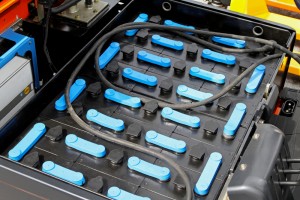 Print a Sign-In Sheet | Spanish Version
Print a Sign-In Sheet | Spanish Version
Two types of forklift batteries are in use today. The first is a recently developed sealed battery. This type does not require any attention from the user because it cannot be recharged.
The more common type contains liquid sulfuric acid electrolyte. Before charging this type of battery, the electrolyte in each cell must be checked and adjusted by removing the cap and adding water from a clean container to bring the level slightly above the plates. Tap water is fine to use unless the water is alkaline, making distilled water necessary. Always wear eye protection when working with batteries because even a small amount of sulfuric acid can cause serious damage to the eyes.
After the electrolyte level has been adjusted, the battery can be connected to the charger. At this point, it is important to be sure the charger connector is plugged into the battery. With the frequently used “SB” connectors, many mistakenly plug the charger into the forklift plug instead of into the battery.
Many of the chargers in use today have automatic start/stop. All that needs to be done with these chargers is to plug them into the battery. They automatically will sense the requirements of the battery and will charge it accordingly. Older chargers have a timer that must be set manually. The timer dial is normally marked “daily charge” and “weekly charge.” The weekly charge is used to ensure equalization of the cells and is most often used over the weekend when the forklift will not be in use.
When a liquid electrolyte lead acid battery is being charged, it liberates both oxygen and hydrogen. Both of these gasses are flammable. Therefore, make sure that the charging area be well ventilated. Ensure that no smoking, open flames, and sparks occur where batteries are being charged.
Leave the cell caps on the battery during charging. If the battery has a cover, it should be open. If the forklift has covers that enclose the battery, those covers should be open or removed.
Make sure the charger is the correct one for the battery you are about to connect. In many plants with multiple forklifts, you may have batteries of four or five different voltages. Each cell of a forklift battery nominally produces two volts. In order to be certain of the battery and charger match, count the cells in the battery and read the nameplate on the charger.
In some plants, the batteries are taken out of the forklift to be charged. Always keep in mind that lead acid batteries are mostly lead. Batteries that weigh between 3,000 and 4,000 pounds are not unusual. Be certain that the equipment being used to handle the battery is able to support the weight.
Always be sure to read the forklift operating manual for special instructions on recharging the batteries.
KEMI does not assume liability for the content of information contained herein. Safety and health remain your responsibility. This information is to be used for informational purposes only and not intended to be exhaustive or a substitute for proper training, supervision, or manufacturers’ instructions/recommendations. KEMI, by publication of this information, does not assume liability for damage or injury arising from reliance upon it. Compliance with this information is not a guarantee or warranty that you will be in conformity with any laws or regulations nor does it ensure the absolute safety of any person, place, or object, including, but not limited to, you, your occupation, employees, customers, or place of business.

